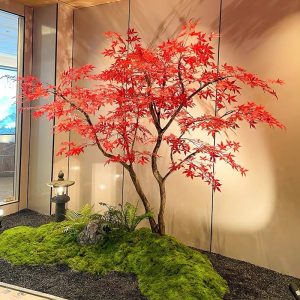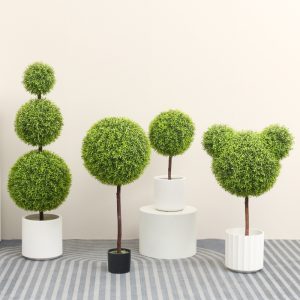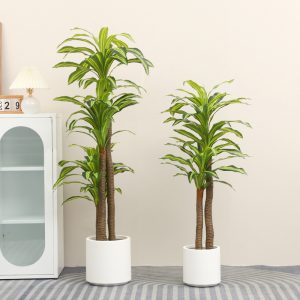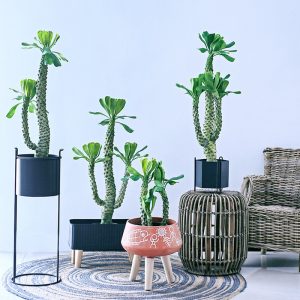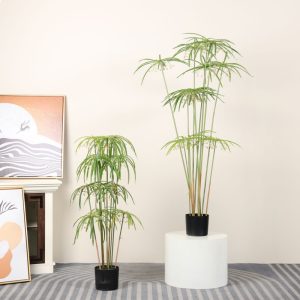At 6:30 AM in the Radisson Hotel in Stockholm, sunlight streams through the floor-to-ceiling windows facing the fjord, casting a light band on the oak floors of the lobby. My colleague Erik crouches by the artificial money tree in the left-side plant area, holding his phone close to a heart-shaped leaf and making a “mute” gesture to me: “Look at the veins in the backlight. The reflection angle is exactly like the real tree I saw in Costa Rica. Who would have thought this is the artificial money tree used in the hotel?” The air is filled with the scent of cinnamon and pine, and the sprawling greenery immediately gives the waking space a breath of life.
Pushing open the heavy wooden doors, the first sight is of three groups of artificial money trees in varying heights. The tallest stands nearly 2.4 meters, its branches stretching toward the wool felt pendant light. The shorter two are nestled beside the light gray sofas. Erik stands up and gently brushes a new curled leaf: “Last week, our Norwegian clients came by, and their designer walked around the tree three times, insisting on getting the contact information for the gardener to take care of the plants at home.”
The lobby follows a Scandinavian minimalist style—with white walls, natural wood furniture, and light gray stone floors. The addition of the artificial money tree brings a lively touch to the simplicity. During noon, when the sunlight is most intense, the leaves cast dancing light spots on the walls; in the evening, as the warm lights come on, the deep green leaves glow with an amber halo, blending with the fireplace’s light. Sofia, the soft furnishings manager, walks by holding a coffee cup: “We tried real money trees before, but in Stockholm’s short winters, the plants lost leaves in less than two months, and the cleaning staff had to pick up fallen leaves every day. After switching to these artificial plants, we saved on weekly watering costs, and dust on the leaves is easily removed with a feather duster.”

We walk to the central lounge area, where the artificial money tree is planted in a white ceramic pot with wavy patterns, echoing the curves of the leaves. “Did you notice?” Erik points to the artificial fuzz on the leaves. “Even the morning dew effect is replicated. This morning, the cleaner said she saw several guests taking pictures of the leaves, thinking we sprayed them with moisturizing water.” A guest with luggage passes by, stops beside the tree to adjust their scarf, and instinctively points their phone camera at the greenery, their mouth curving up in surprise at the discovery.
“We debated plants for two weeks.” Erik takes me to the elevator hall display area, where the tree is paired with a brass plant stand, contrasting with the black-and-white photography on the walls. “Headquarters asked for ‘a natural feel to alleviate the stress of business guests,’ but old European hotels have low ceilings and uneven light. Real plants can’t survive the harsh winter, or require daily adjustments of direction, which is too costly in labor.” He stands on tiptoe to touch a leaf high up. “When we saw the sample, we were amazed. This food-grade silicone material withstands the dryness of heated rooms, and the angle of the leaves’ droop is identical to a three-year-old real tree.”
Olaf from the engineering department passes by with his toolkit and joins the conversation: “I monitored the installation, and it was much easier than I expected. The base has a hidden weight system, so even in strong winds, it remains stable. The most important thing is that it’s environmentally friendly—no pesticides like real plants need, so it’s safe for guest rooms.” He points to the corridor corner decoration: “Last week, a Danish client took photos of the tree trunk texture and plans to use it in their café design, even asking if we had a Scandinavian designer custom-make it.”
Lina from the purchasing department walks over, flipping to the maintenance cost page: “We used to spend 800 euros a month just on fertilizing and pruning real trees, not including replacement costs for dead plants. After switching to the artificial money tree used in the hotel, we saved that money, and our guest satisfaction survey showed a 12% increase in ‘environment comfort’ scores.” She points to a guest comment: “This one: ‘The lobby plants remind me of my grandmother’s garden, and I can feel nature’s warmth even on a business trip.’ That’s exactly the effect we wanted.”
In the afternoon executive lounge, sunlight filters through the blinds, turning into grid-like light spots that fall on the artificial money tree by the window. A few business guests sit and talk, occasionally brushing the branches hanging near the table. Erik whispers: “Did you notice? Compared to plastic fake plants, this one doesn’t have a ‘cheap’ feel. The leaves have varying shades, and the branch forks are natural. Guests don’t avoid it; in fact, they interact with it as if it were a real plant.”
Anna from the housekeeping department passes by with a linen cart: “The small artificial money trees in the guest rooms are the most popular! Especially in the north-facing rooms, where we couldn’t keep real plants alive before. Now, with these artificial plants, guests often ask where they can buy them when checking out. One American guest even asked for care instructions, saying they wanted to put one in their home office.” She points to the suite entrance: “We adjust the pot height according to the room’s style. For modern rooms, we use cement pots; for retro styles, we pair them with wicker baskets. Guests say it feels like staying in a villa with its own personal gardener.”
As evening falls, the lobby gets busier. Receptionist Emma guides guests through the check-in process, while the artificial money tree behind her glows in the warm light. “One time, during a rainstorm, a guest whose flight was delayed sat by the tree for three hours. When they left, they said, ‘Seeing these leaves that won’t be damaged by wind and rain really calmed me down,'” Emma says. “This is the magic of artificial plants—they always stay in perfect condition, offering comfort no matter the weather.” A child runs by, trying to touch the leaves, and the mother gently reminds, “Be careful, sweetie,” adding a tender warmth to the artificial plant.
As the hotel quiets down late at night, the duty manager dims the lights. Moonlight shines through the clouds, casting a silver glow on the artificial money tree. Erik watches the gently swaying greenery: “A hotel is not just a place to sleep, but a temporary home for travelers. This artificial money tree, which doesn’t require constant care but always stays vibrant, has become the hotel’s most reliable partner.”
When the morning mist rises from the fjord and sunlight pours into the lobby again, the artificial money tree continues to stretch its branches, welcoming each guest. In this city where snow and darkness reign for half the year, this eternal greenery adorns the space and brings an added warmth to every journey.








